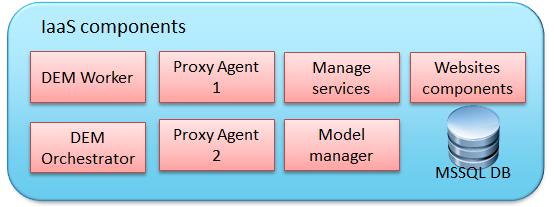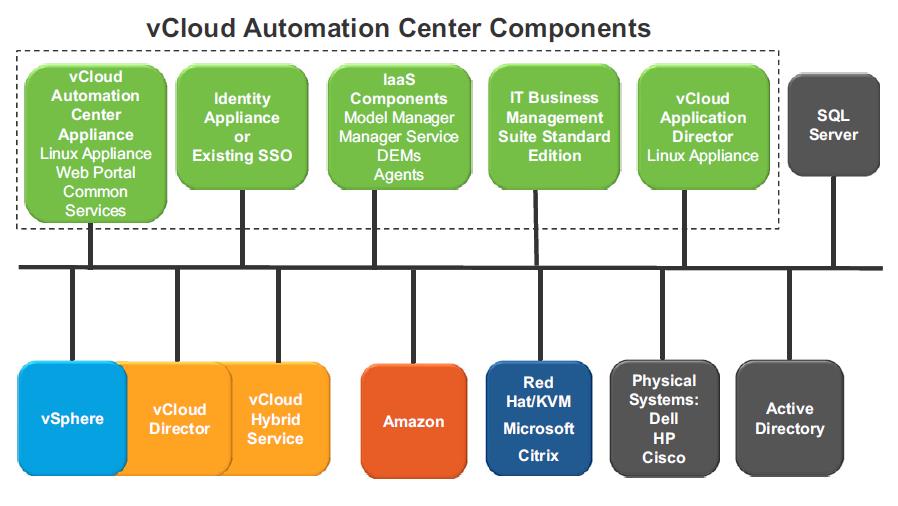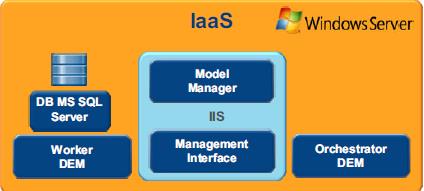vCloud Automation Center vCAC 6.0 required 3 important components. We should install and configure the below 3 components and its sub components properly to make use of vCAC website to provision and manage the cloud services along with authoring, administration and governance. ITBM and vCloud Application Director are add-on optional components. ITBM(IT Business Management) helps you to examine the financial data of your infrastructure. vCloud Application Director delivers the application services.
Graphic Thanks to VMware.com
It should be installed and configured in the below order:
1.Identity Appliance – The Identity Appliance is a pre-configured virtual appliance that provides single sign-on for vCloud Automation Center. It is delivered as an open virtualization format (OVF) template. You can also use the SSO services from VMware vCenter Deployment If you are running vSphere 5.5 Update 1
2. vCloud Automation Center Appliance – The vCloud Automation Center Appliance is a pre-configured virtual appliance(OVF) that deploys the vCloud Automation Center Appliance server. It provides the Single portal for self-service provisioning and management of cloud services , as well as authoring,administration and governance. For High Availbality of Portal,you can deploy multiple instances of vCloud Automation Center appliance behind Load balancers
3. Iaas Components Server (Should be installed on Windows Server and MS SQL Database is Mandatory) : Infrastructure as a Service (Iaas)enables the rapid modeling and provisioning of servers and desktops across virtual and physical,private and public, or hybrid cloud infrastructures. Iaas Components of vCAC includes multiple component:
Graphic Thanks to VMware.com
- IaaS Website
- Distributed Execution Managers(DEM)
- Agents
- Model Manager
- Manager Service
- Database
IaaS Website : provides the infrastructure administration and service authoring capabilities to the vCloud Automation Center console. The Website component communicates with the Model Manager, which provides it with updates from the Distributed Execution Manager (DEM), proxy agents and database.
Model Manager : The Model Manager communicates and integrates with external systems and databases. Models included in the Model Manager implement business logic that is executed by a DEM. The ModelManager provides services and utilities for persisting, versioning,securing, and distributing model elements. The Model Manager communicates with a Microsoft SQL Server database, the DEMs, and the console Web site.

Distributed Execution Managers :DEM executes the business logic of custom models, interacting with the IaaS database andexternal databases.
Proxy agents – virtualization, integration and WMI agents that communicate with infrastructure resources
DEM instances can be deployed in one of two forms:
DEM Orchestrator
- Preprocesses workflows, schedules workflows, and monitors DEM Worker instances.
- Only one DEM Orchestrator is active at a given time. A standby should be deployed for redundancy.
DEM Worker
- Communicates with the external systems
- Responsible for executing workflows
Manager Service : The Manager Service coordinates communication between agents,the IaaS database, Active Directory (or LDAP), and SMTP. The Manager Service communicates with the console Web site through the Model Manager.
Agents: Agents, like DEMs, are used to integrate vCloud Automation Center with external systems:
- Virtualization proxy agents are used to collect data from and provision virtual machines on virtualization hosts, for example, a Hyper-V agent,a vSphere agent, or a Xen agent.
- Integration agents provide vCloud Automation Center integration with virtual desktop systems, for example, an EPI Windows PowerShell agent, or a VDI Windows PowerShell agent.
- Windows Management Instrumentation agents enable data collection from Windows machines managed by vCloud Automation Center.
I hope this is informative for You. Thanks For Reading!!!. Be Social and share it in Media, if you feel worth sharing it.



